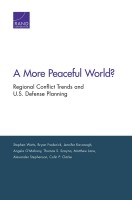| 来源类型 | Research Reports
|
| 规范类型 | 报告
|
| DOI | https://doi.org/10.7249/RR1177
|
| ISBN | 9780833095534
|
| 来源ID | RR-1177-A
|
| A More Peaceful World? Regional Conflict Trends and U.S. Defense Planning |
| Stephen Watts; Bryan Frederick; Jennifer Kavanagh; Angela O'Mahony; Thomas S. Szayna; Matthew Lane; Alexander Stephenson; Colin P. Clarke
|
| 发表日期 | 2017
|
| 出版年 | 2017
|
| 页码 | 298
|
| 语种 | 英语
|
| 结论 |
Armed Conflict Has Declined- In broad terms, the incidence of armed conflict has declined in both number and intensity since the end of the Cold War, with particularly sharp declines in higher-intensity conflicts.
- There has been an uptick in some forms of intrastate conflict in 2013–2015, but the current spike in armed conflict is likely to prove relatively short-lived. It could easily last for several more years, but it is unlikely to represent a "new normal" — that is, a decades-long increase in the incidence of war.
The Trend of Declining Conflict Is Likely to Continue- Approximately a dozen key factors together explain much of the historical variation in levels of war and conflict, and the long-term trends in nearly all of these factors have been conducive to peace.
- Unless the wars of the future have different causes than those of the past, for the conflicts of the past few years to represent the beginnings of a long-term rise in conflict, the decades-long trends toward higher levels of development, more open economies, more democratic governance, and stronger international institutions and norms of peaceful conflict resolution (among others) would have to suffer large and sustained reversals — reversals that have occurred only in crises such as the Great Depression or the early years of the Cold War.
|
| 摘要 |
- This report recommends using five indicators as the most important sources of warning that conflict trends may be increasing over our baseline projections: recent power transitions (which increase the likelihood of interstate wars); new, higher-salience territorial claims (which are also positively correlated with interstate war); ratios of trade to gross domestic product (GDP) (where greater economic interdependence reduces the likelihood of interstate war); recent democratizing transitions (which are associated with an increase intrastate conflict); and annual GDP growth rates (where increases in growth rates reduce the likelihood of intrastate conflict).
|
| 主题 | Democracy
; Global Security
; International Diplomacy
; Low-Intensity Conflict
; Military Force Planning
; Threat Assessment
|
| URL | https://www.rand.org/pubs/research_reports/RR1177.html
|
| 来源智库 | RAND Corporation (United States)
|
| 引用统计 |
|
| 资源类型 | 智库出版物
|
| 条目标识符 | http://119.78.100.153/handle/2XGU8XDN/108561
|
推荐引用方式
GB/T 7714 |
Stephen Watts,Bryan Frederick,Jennifer Kavanagh,et al. A More Peaceful World? Regional Conflict Trends and U.S. Defense Planning. 2017.
|
|
文件名:
|
x1505217213302.jpg
|
|
格式:
|
JPEG
|

|
文件名:
|
RAND_RR1177.pdf
|
|
格式:
|
Adobe PDF
|
除非特别说明,本系统中所有内容都受版权保护,并保留所有权利。